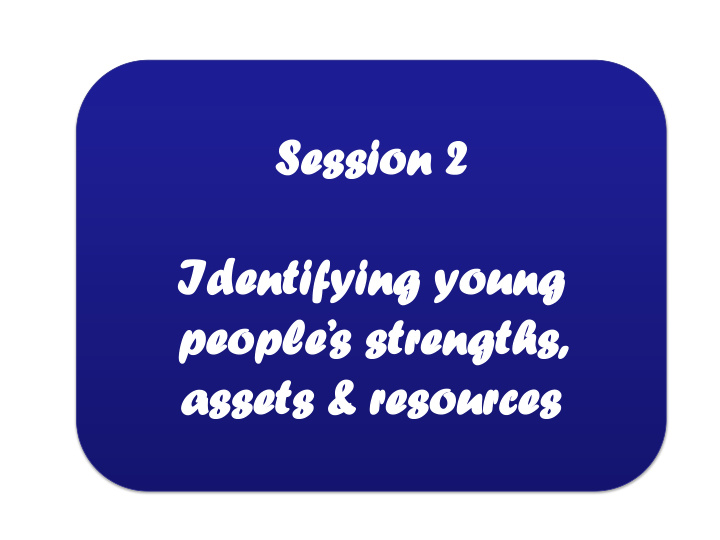



Resilience Theory & Strengths-based approach • Over recent years - a shift in research and service delivery from a deficits-based approach to an approach that highlights strengths, resources and assets that may enable positive outcomes. • This focus on strengths-based approaches has led to a rise in research on resilience. (http://www.aifs.gov.au/cfca/pubs/papers/a141718/08.html ) • Although there are many varied definitions of resilience, most suggest that it involves children displaying competent functioning despite exposure to high levels of risk or adversity. – E.g. "Resilience is the happy knack of being able to bungy jump through the pitfalls of life." (Fuller, 1998, p. 75)
Resilience Theory & Strengths-based approach • A resilience-based approach to youth development is based upon the principle that all people have the ability to overcome adversity and to succeed in spite of their life circumstances. • Resilience is a strengths-based construct, meaning its focus is on providing the developmental supports and opportunities (protective factors) that promote success, rather than on eliminating the factors that promote failure. • Research has consistently shown that the presence of protective factors provide a better indicator of whether young people will grow up to become successful, well-adjusted adults than does the presence or absence of risk factors (i.e. poverty, drug-use, etc.)
Resilience Theory & Strengths-based approach • The strengths-based approach focuses on strengths (i.e. competencies, resources, personal characteristics, interests and motivations) of individuals, family or community (McCashen, 2005; Saleenbey, 1996). • Strengths-based practice: = moving from the more traditional focus on deficits to a focus on abilities, strengths and resources. = recognising that everyone has the strengths to aid them towards healthy growth and development. (Strengths Institute, n.d.) This is in line with resilience theory that most people will do well despite exposure to adversity (Masten, 2001).
Resilience Theory & Strengths-based approach Why is this s importa rtant in Youth h Work? k??? ?? • Resilience = the theory that identifies the importance of protective factors, competencies, assets and resources in a young person’s life. • Strengths-based approach = the practical application of this theory and relates to how we work with young people as well as what we do with them to build strengths, resources, assets and competencies.
40 Developmental Assets Search Institute, Minneapolis http://www.search-institute.org/content/40-developmental-assets-adolescents-ages-12-18
Source: Dale Blyth, University of Minnesota Presentation at DCYA Symposium on Exploring Outcomes in Youth Work and Relater Provision, Dublin Castle, 24 th July, 2012
Source: Dale Blyth, University of Minnesota Presentation at DCYA Symposium on Exploring Outcomes in Youth Work and Relater Provision, Dublin Castle, 24 th July, 2012
Asset Mapping with young people • Derived from ABCD – Asset Based Community Development • Asset mapping engages the target group to identify and provide information about the strengths and resources of a group /community and can help uncover solutions. • Once strengths and resources are identified, documented and depicted in a map, you can more easily think about how to build on these assets to address group /community needs and contribute to social and personal development. • Asset mapping promotes young people’s involvement, ownership, and empowerment.
Steps in Asset Mapping with Youth People • Define the boundaries – who to involve and where (geographical) ….individual or group asset mapping? Both? • Identify and involve partners – other agencies, young people themselves, family, peers, experts, etc. • Determine what type of assets to include e.g. economic or environmental resources, physical assets, knowledge, skills, abilities & interests of young people, access to educational and social opportunities, facilities and services for young people, etc (determined by the purpose of your asset mapping exercise) and linking with your needs assessment purpose and process. • Engage young people in identifying and listing their assets, resources, strengths etc. • Use creative methodologies to organise findings onto a ‘map’. Photovoice, graphic harvesting, mind mapping, world café methodologies can all be useful in doing this. (Adapted from: UCLA Centre for Health Policy Research)
http://sustainablecities.net/our-work/youth- led-development/youth-led-development- projects/item/3-mapped-vancouvers-youth- asset-mapping-project
References • Hunter, C (2012). Is Resilience still a useful concept in working with children and young people? Child and Family Community, Australia http://www.aifs.gov.au/cfca/pubs/papers/a141718/cfca02.pdf • Fuller, A. (1998). From surviving to thriving: Promoting mental health in young people . Camberwell: The Australian Council for Educational Research Ltd. • McCashen, W. (2005). The strengths approach . Bendigo : St Luke’s Innovative Resources. • Saleebey, D. (1996). The strengths perspective in social work practice: Extensions and cautions. Social Work, 41 (3), 296 – 305. • Strengths Institute. (n.d.). What is the strengths perspective? Retrieved from www.socwel.ku.edu/strengths/about/index.shtml • Masten, A. S. (2001). Ordinary magic: Resilience processes in development. American Psychologist, 56 (3), 227 – 238.
Recommend
More recommend